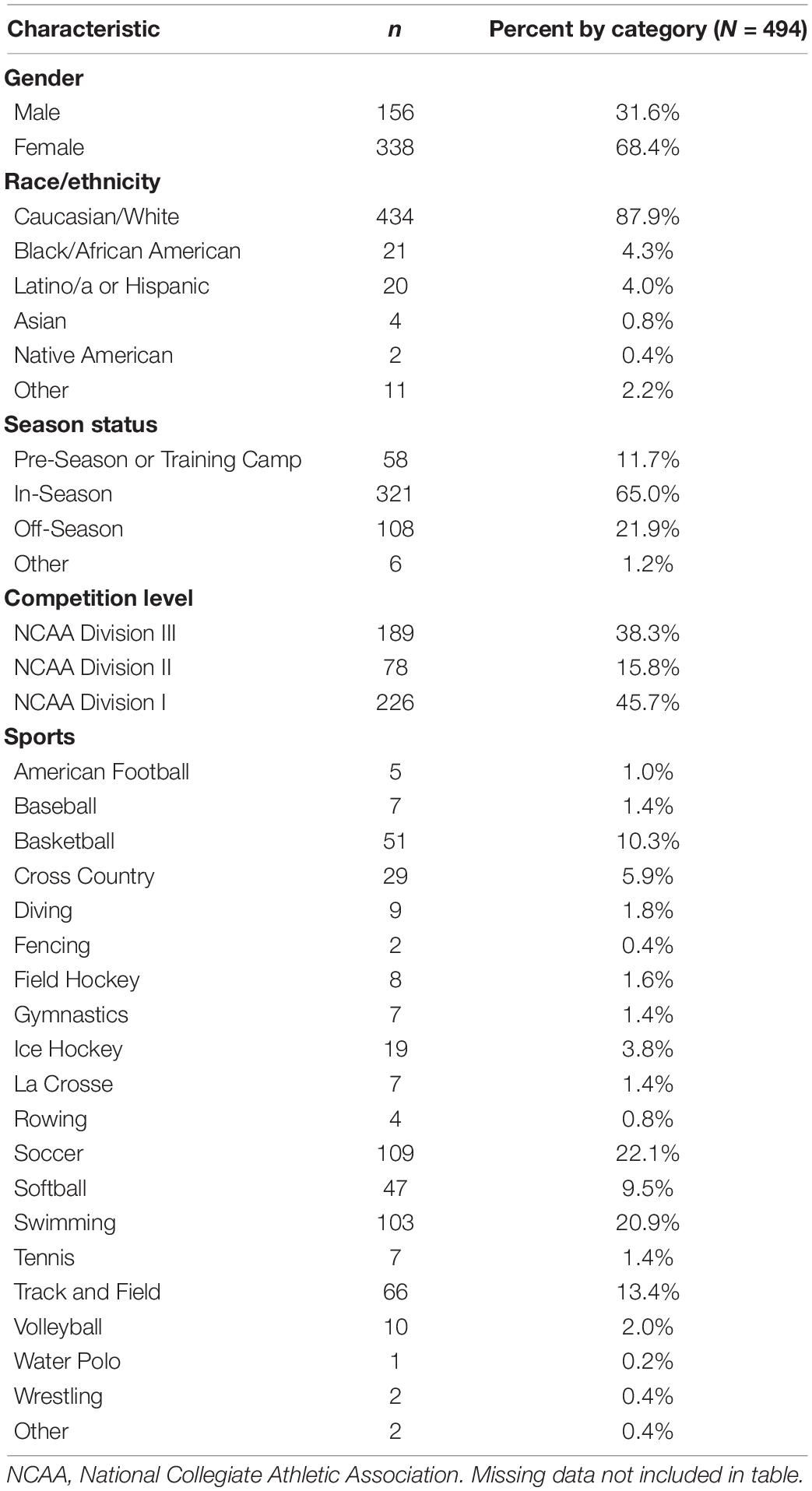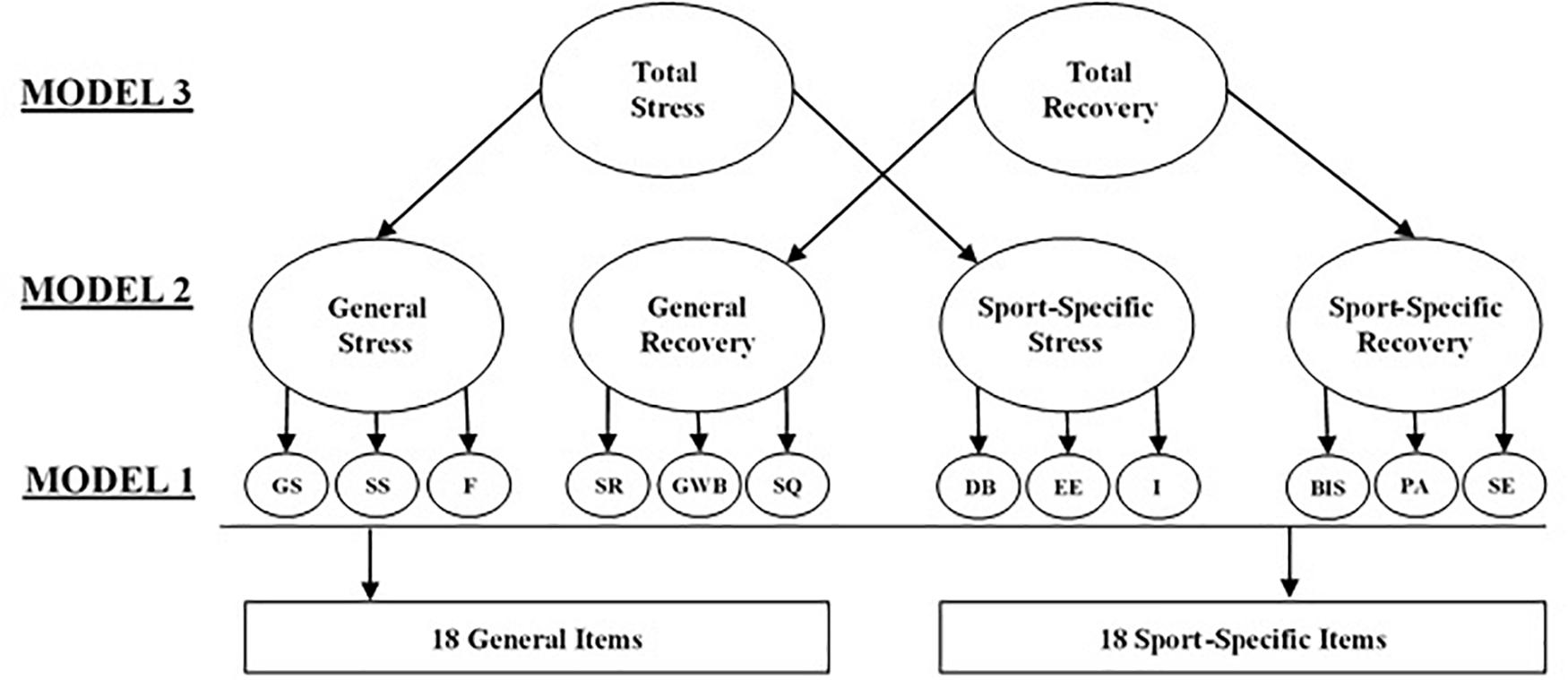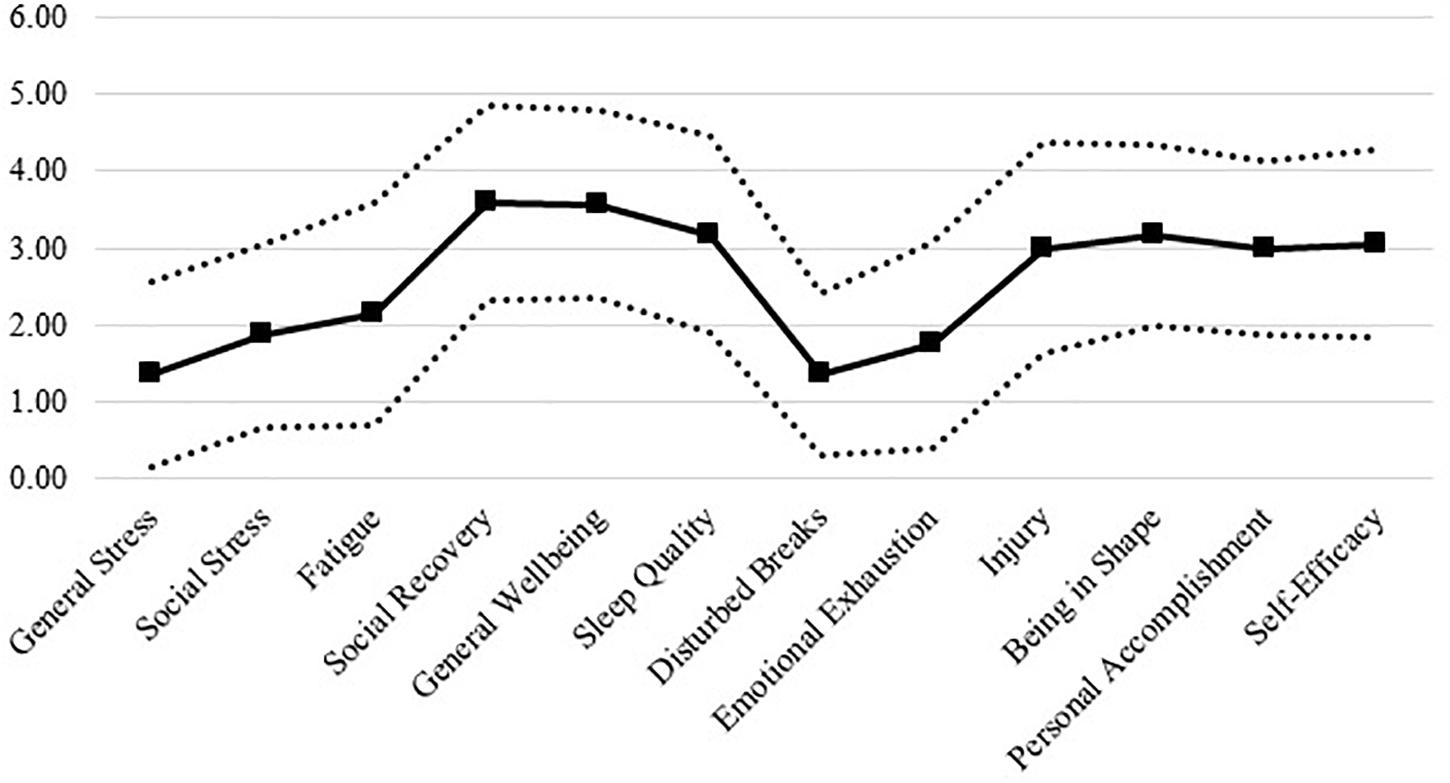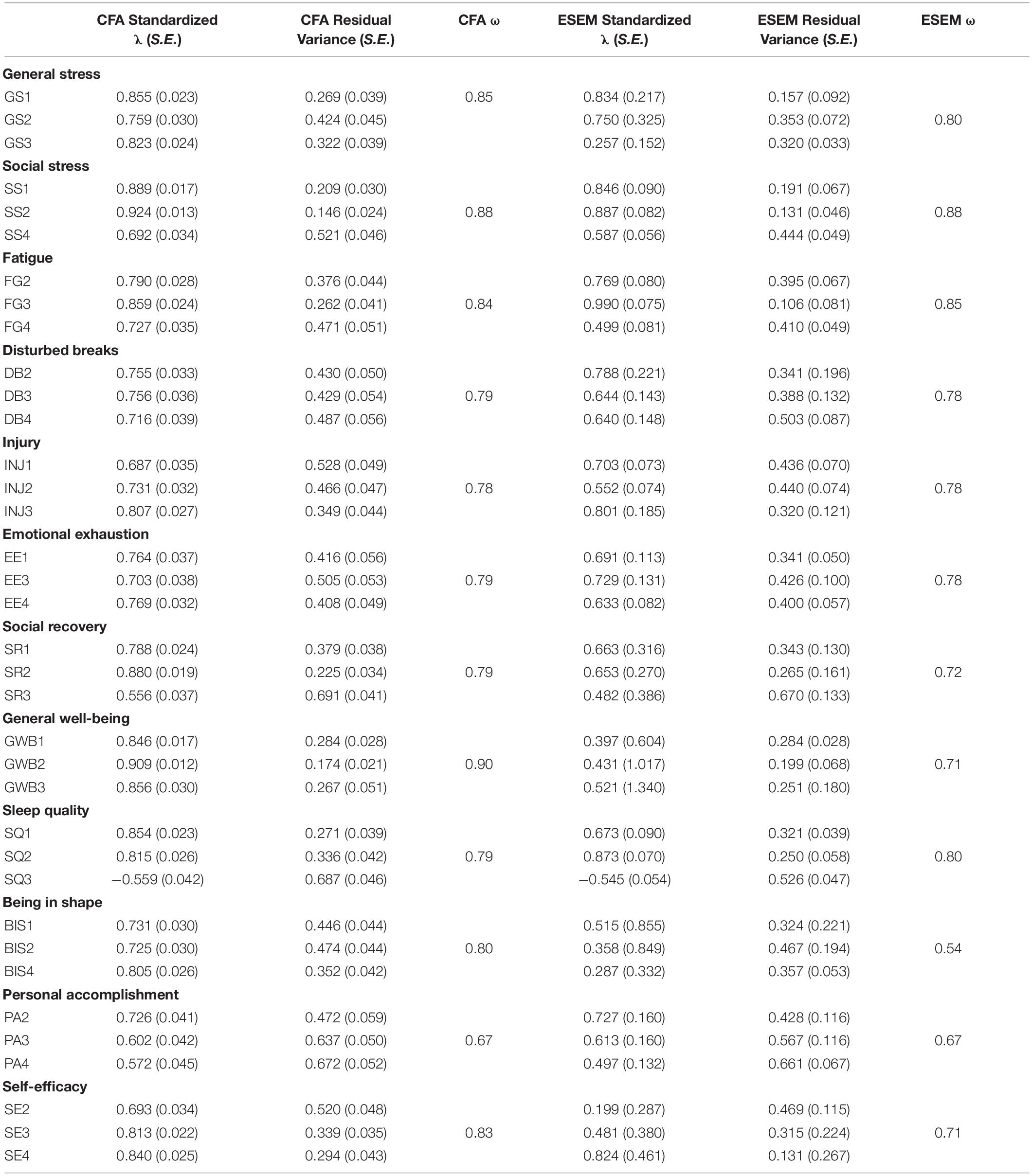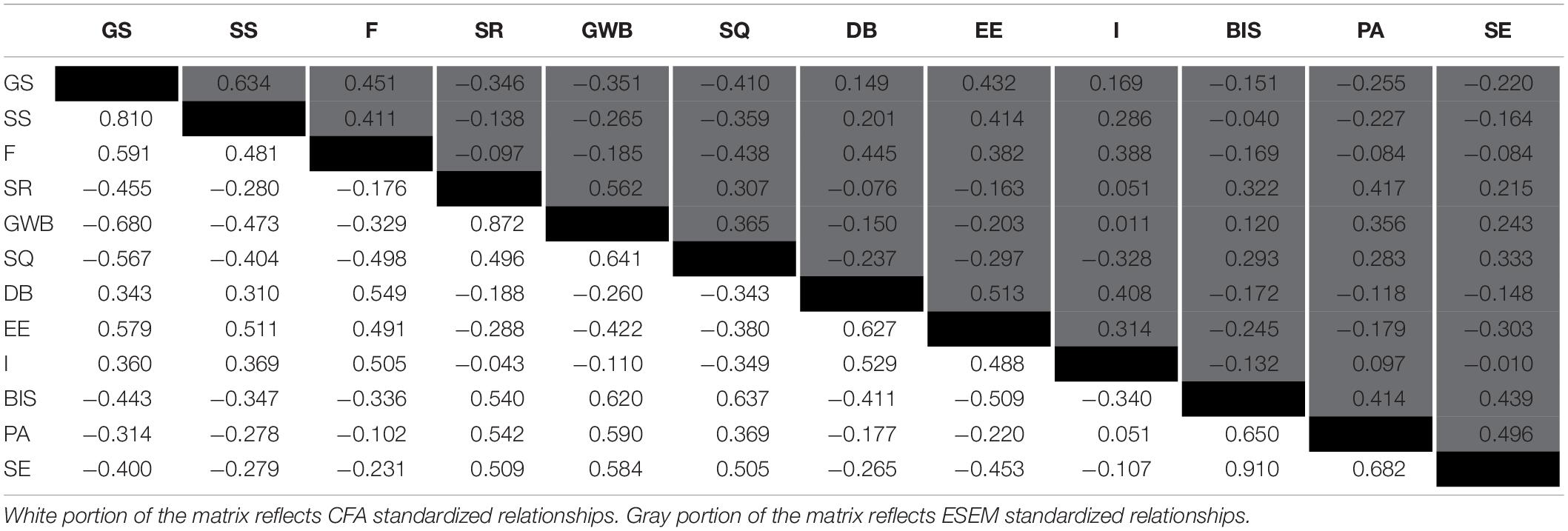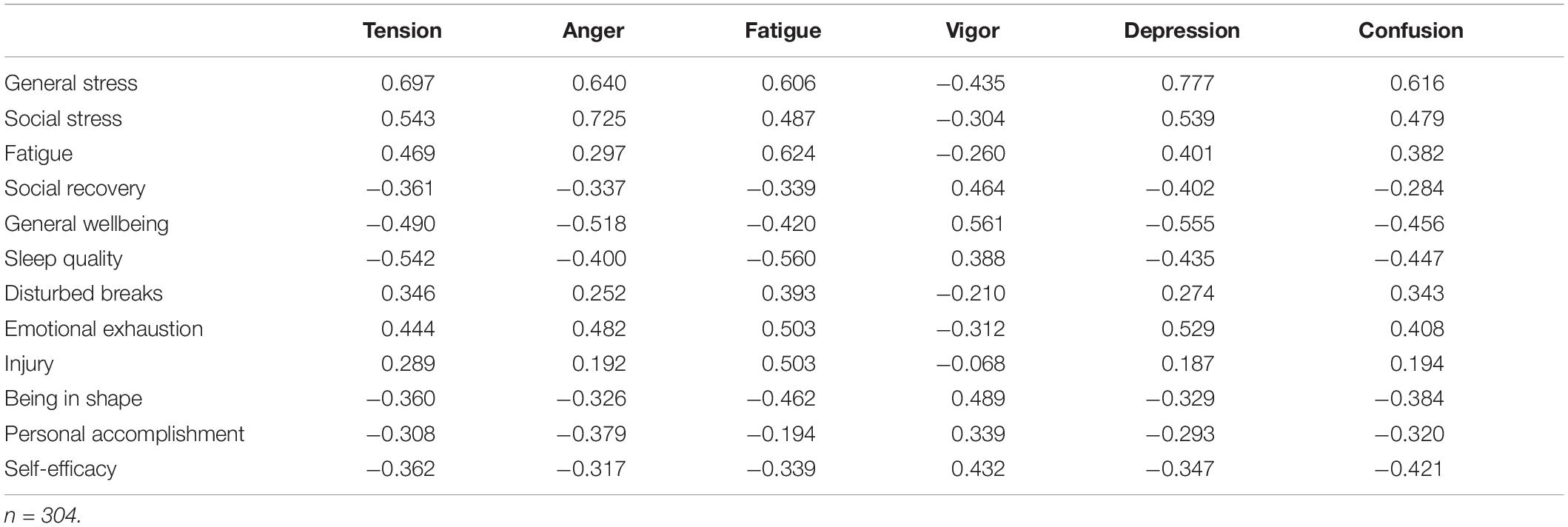- 1Department of Health Sciences, Drake University, Des Moines, IA, United States
- 2Laboratory for Sport Psychology & Performance Excellence, Department of Rehabilitation Sciences & Technology, University of Wisconsin-Milwaukee, Milwaukee, WI, United States
The purpose of the current study was to examine the reliability and validity of the RESTQ-Sport-36 for use in the collegiate student-athlete population. A total of 494 collegiate student-athletes competing in National Collegiate Athletic Association Division I, II, or III sanctioned sport completed the RESTQ-Sport-36 and Brief Profile of Mood States (POMS). Structural equation modeling (SEM) procedures were used to compare first order to hierarchical model structures. Results of a confirmatory factor analysis (χ2[528] = 1129.941, p < 0.001; SRMR = 0.050; CFI = 0.929) and exploratory structural equation modeling analysis (χ2[264] = 575.424, p < 0.001; SRMR = 0.013; CFI = 0.963) indicated that the first order 12-factor structure demonstrated the best fit of all models tested. Support was not observed for the fit of any hierarchical model. Moderate to strong correlations were observed between stress and recovery subscales and mood states, thus supporting the construct validity of the abbreviated RESTQ measurement model. The current findings provide support for the measure’s use in this population and give pause as it relates to the scoring and interpretation of hierarchical factors such as Total Stress and Total Recovery. Overall, the current results indicate that the RESTQ-Sport-36 may be a useful tool for collegiate student-athlete training load and competition monitoring.
Introduction
The contemporary sport performance literature highlights the benefit of incorporating psychological surveys within elite athlete training load monitoring and management protocols (Saw et al., 2016; Schwellnus et al., 2016; Soligard et al., 2016; Bourdon et al., 2017). Among other measures like the Profile of Mood States (POMS), the Recovery Stress Questionnaire for Athletes (RESTQ-Sport, Kallus and Kellmann, 2016) is one of the most frequently used measures for monitoring elite athlete responses to training load (Saw et al., 2016; Kellmann et al., 2018). Across primary research studies, collective evidence indicates that the RESTQ-Sport is sensitive to changes in training load (Kölling et al., 2016; Nicolas et al., 2019), illness or injury risk (Laux et al., 2015; van der Does et al., 2017; Heidari et al., 2018), and performance (Filho et al., 2015; Otter et al., 2016). Despite the strengths of the measure, and the overwhelming popularity of the RESTQ-Sport among researchers and practitioners alike, studies examining the psychometric properties of the original RESTQ-Sport measure have generated conflicting results over the past 20 years (Kellmann and Kallus, 2001; Davis et al., 2007; Martinent et al., 2014; Kallus and Kellmann, 2016).
Concurrent with the widespread popularity of the original 76-item RESTQ-Sport measure among researchers, the authors developed a shortened 52-item version. While some researchers utilized this measure (Tessitore et al., 2011; Kuan and Kueh, 2015; Laux et al., 2015), the 76-item RESTQ-Sport, by far, remained the most used form in research studies. Due to the growing practical concerns regarding the psychometric properties, measure length, scoring procedures, and translational utility of 76-item RESTQ-Sport data to inform interventions aimed at overtraining prevention (Taylor et al., 2012; Saw et al., 2015), the authors recently developed a further abbreviated 36-item version called the RESTQ-Sport-36 (Kallus and Kellmann, 2016). In comparison to the longer versions, the RESTQ-Sport-36 involves a balanced measurement model (i.e., 12 factors, 3 items per factor) while eliminating conceptually redundant factors and items. Using structural equation modeling (SEM) procedures to analyze data from a sample of German athletes, Kallus and Kellmann (2016) reported support for model fit across individual subscales. To the extent of the authors’ knowledge, no examinations of hierarchical models were conducted in this initial validation.
Nicolas et al. (2019) conducted additional research to support the psychometric properties of the RESTQ-Sport-36 among French-speaking athletes. Superior model fit was reported for the 12-factor measurement model (χ2 [528] = 1215.36, p < 0.001; RMSEA = 0.05; CFI = 0.951), over all hierarchical models. Further, reliability estimates for each of the subscales were interpreted as acceptable, with the exception of the Disturbed Breaks and Social Recovery factors. Although strong psychometric properties of the measure have been observed among European elite athletes, RESTQ-Sport-36 reliability and validity have yet to be established among English-speaking or United States-based athletes.
It should be noted that neither Kallus and Kellmann (2016) nor Nicolas et al. (2019) found evidence to support the measurement of hierarchical constructs like Total Stress or Total Recovery, yet these variables are used frequently in research methods. Drawing back to the larger body of RESTQ literature, such discrepancies in scoring, and therefore statistical analysis, may be contributing to the inconsistencies found across studies and/or questions surrounding the practical meaning of findings generated. Critical examinations of the validity of construct measurement across levels within a hierarchical structure like the RESTQ-Sport-36 are necessary, as even a cursory review of the RESTQ literature reveals significant variation in the scoring procedures used by different research teams (e.g., van der Does et al., 2015; Otter et al., 2016). As such, additional investigations are needed to confirm the most valid means of scoring the RESTQ-Sport-36 to advance this area of the literature. Such research would support the translatability of RESTQ-Sport-36 data, advancing this well-established monitoring or “red flagging” tool to one which can inform the design of precise and effective recovery interventions.
Finally, scientists have only recently shifted attention toward monitoring training load among collegiate student-athletes in the United States (Conte et al., 2018; Flatt et al., 2018; Govus et al., 2018; Hamlin et al., 2019; Huggins et al., 2019; Sampson et al., 2019). Previous research has demonstrated that the collegiate student-athlete population may experience elevated levels of stress and burnout due to perfectionistic tendencies, competing demands as student and athlete, insufficient self-regulation skills, as well as responses to training load and competition (Gould and Whitley, 2009; Dubuc-Charbonneau and Durand-Bush, 2015; Garinger et al., 2018; Huml et al., 2019). Other research has noted that the strength of student-athletes academic and athletic identities varies by age and competition levels (Lupo et al., 2017a), and that student-athlete motivation toward a dual-career may be influenced by gender, age, competition level, type of sport, and year of attendance (Lupo et al., 2017b). Such findings support the value of monitoring the stress and recovery experiences of student-athletes, to support their health and well-being amidst progression toward academic, sport, or dual-career goals. Despite this growing need to monitor collegiate student-athlete responses to training load and competition, researchers have yet to apply any of the RESTQ-Sport derivative measures within this population. The RESTQ-Sport-36 specifically could be used as a brief and valid tool to assess collegiate student-athlete internal load, thus adding depth and rigor to the overall training load monitoring protocols already in place. Within a robust United States collegiate student-athlete sample, the purposes of this study were to: (a) examine the reliability and structural validity of the RESTQ-Sport-36 using SEM procedures and (b) examine construct validity of the RESTQ-Sport-36 via correlations between its subscales and mood states as measured by the Brief POMS. An additional applied purpose of the study was to determine best scoring methods for the RESTQ-Sport-36.
Materials and Methods
Participants
Participants were solicited via e-mail recruitment flyers, word-of-mouth, and personal invitation through existing collaborations with the second author. Athletes (N = 494, mean age = 19.7 ± 1.4, 68.4% female) currently participating in a variety of sports volunteered to participate in the current study. Sample demographics are reported in Table 1. All participants were competing in a National Collegiate Athletic Association (NCAA) Division I, II, or III sanctioned sport at the time of survey completion.
Measures
The RESTQ-Sport-36 (Kallus and Kellmann, 2016) was administered first to each participant. Adapted from the original RESTQ-Sport measure (Kellmann and Kallus, 2001; Kallus and Kellmann, 2016), the hypothesized model consists of 36 items and 12 first-order factors, with three items used to measure each factor. Second-order factors consisted of General Stress, General Recovery, Sport-specific Stress, and Sport-specific Recovery. Third-order factors consisted of Total Stress and Total Recovery. The hypothesized measurement model structures are shown in Figure 1. All items in the RESTQ-Sport-36 begin with the stem of “In the past 3 days/nights,” and athletes indicated item responses on a 7-point Likert scale ranging from never (0) to always (6). Item responses, treated as interval or continuous data, were interpreted as athletes’ perceived frequency of events and behaviors.
The Brief Profile of Mood States (Brief-POMS) was administered to assess athlete mood states (McNair et al., 1992). The Brief-POMS is a 30-item measure, with items scored on a 5-point Likert scale ranging from 0 (not at all) to 4 (extremely). All items reflect descriptions of feelings over the past week. The reliability and validity of the measure for use in adult populations has been established in previous research (McNair et al., 1992; Bourgeois et al., 2010). Calculated as the sum of all items, each mood state score ranged from 0 to 20.
Procedure
Prior to participant recruitment, study methods were reviewed and approved by the institutional review board at the second author’s affiliate university. Athletes who completed the informed consent to participate submitted their Qualtrics online survey responses between August 2016 and February 2017. Participants completed a demographic survey, the RESTQ-Sport-36, and the Brief-POMS at a location and time of their convenience, amounting to approximately 10–15 min for survey completion. All survey responses were collected anonymously.
Statistical Analysis
All SEM analyses were performed using Mplus 8.0 software (Muthén and Muthén, 2011). To determine the most parsimonious factor structure of those shown in Figure 1, the hypothesized models were tested in order of structural complexity using confirmatory factor analysis (CFA) procedures. Model 1 represented the first order factor structure, in which 36 items load onto 12 latent variables. Model 2 represented the structure described in Model 1, with the addition of the four second order General and Sport-specific latent variables. Model 3 represented the structure described in Model 2, with the addition of the two third order Total Stress and Recovery latent variables.
To account for potential cross-loading across items and to support flexibility in the representation of a complex measurement model such as the RESTQ-Sport-36, an exploratory structural equation modeling (ESEM) procedure was also applied to Model 1. Within the ESEM procedure, a target (orthogonal) rotation was used. Goodness of fit was compared across all models tested to evaluate parsimony. To determine subscale reliability, McDonald’s omega coefficient computations were performed using parameters obtained from both the CFA and the ESEM first order model. Omega coefficients of greater than 0.70 were considered acceptable. Missing data were treated as missing completely at random, and thus treated using full information maximum likelihood estimation for incomplete data procedures (Enders and Bandalos, 2001; Kline, 2011).
The covariance matrix was analyzed using the maximum likelihood (ML) estimation procedure. The covariance matrix utilized is presented within the Supplementary Material. To define units within Model 1, the unstandardized loading of one item from each first order latent variable was constrained to 1.0. For Models 2 and 3, a standardization approach was utilized, whereby the variance of a common factor was constrained to 1.0. Results from previous simulation studies have demonstrated that when items are evaluated by 5 or more categories, data are normally distributed, and adequate sample size is achieved, acceptable model rejection rates are yielded by ML estimation methods (Beauducel and Herzberg, 2006; Rhemtulla et al., 2012). To evaluate the model fit, the chi-square test of fit, residuals-based indices (i.e., root mean square error of approximation [RMSEA], standardized root mean square residual [SRMR]), and incremental fit indices (i.e., comparative fit index [CFI], Tucker-Lewis index [TLI]) were calculated and reported. All calculated model fit indices were collectively evaluated in light of previous literature on model fit determinations (Hu and Bentler, 1999; Kenny and McCoach, 2003; Marsh et al., 2004; Jackson et al., 2009).
Relationships between RESTQ-Sport-36 variables and mood states were examined using Pearson correlation coefficients. Given that this analysis was performed to explore construct validity, statistical significance was not interpreted as meaningful. Rather, correlation coefficient magnitudes of 0–0.3 were interpreted as weak, 0.3–0.7 were interpreted as moderate, and 0.7–1.0 were interpreted as strong. As the Brief POMS was administered after the RESTQ-Sport-36, attrition during survey completion was observed. A significant proportion of athletes did not complete the Brief POMS after completing the RESTQ-Sport-36 (38.5%). As such, listwise deletion was used to ensure that only complete responses from athletes were used in the analysis. A final sample size of 304 was used for the correlation analysis.
Results
Descriptive statistics for RESTQ-36-Sport responses are displayed in Figure 2.
Model fit comparisons are presented in Table 2. Measurement model parsimony was observed in Model 1 (χ2[528] = 1129.941, p < 0.001; SRMR = 0.050; CFI = 0.929), indicating that the first order 12-factor structure is the best fitting model of the three models tested. Support was not observed for the fit of any hierarchical model. This finding was further reinforced by the ESEM model test (χ2[264] = 575.424, p < 0.001; SRMR = 0.013; CFI = 0.963), which demonstrated improvements in the SRMR and CFI parameters beyond those which were observed in the CFA procedure for Model 1. Model parameter estimates, residual variances, and omega coefficients of the good-fitting models are reported in Table 3. It is worth noting that some standardized factor loadings (e.g., GS3, BIS4, SE2, see) from the ESEM were smaller in magnitude than the standardized factor loadings from the CFA, indicating that the proportion of indicator variance explained by the respective factor is affected by whether or not the model accounts for cross-loading. For example, only 6.6% of the variance in GS3 is accounted for by General Stress using the ESEM procedure. All other items loaded appropriately on to the respective factors, and factor loadings and residual variances were consistent with theory. Omega coefficients demonstrated acceptable levels of reliability for all subscales except Personal Accomplishment (both CFA and ESEM procedures) and Being in Shape (ESEM procedure only). Standardized relationships between first order latent variables from the CFA and ESEM models are displayed in Table 4. The directionality and magnitudes of relationships observed are consistent with the underlying measurement theory (Kallus and Kellmann, 2016).
In terms of the relationships between RESTQ-Sport-36 subscales and mood states as measured by the Brief POMS, moderate to strong relationships exist between General Stress, Social Stress, General Well-being, Sleep Quality, Emotional Exhaustion, Being in Shape, and Self-Efficacy and all six mood states. Weak correlations were observed between Fatigue, Disturbed Breaks, and Injury and mood states like Anger, Vigor, Depression, and Confusion. Of the mood states, Tension and Fatigue shared moderate to strong correlations with most if not all of the RESTQ-Sport-36 subscales. Pearson correlation coefficients are reported in Table 5.
Discussion
Within a robust United States collegiate student-athlete sample, the purposes of this study were to: (a) examine the reliability and structural validity of the RESTQ-Sport-36 using SEM procedures and (b) examine construct validity of the RESTQ-Sport-36 via correlations between its subscales and Brief-POMS mood states. An additional, applied purpose of the study was to determine best scoring methods for the RESTQ-Sport-36. Results of the current study indicate that the 12-factor, first order model is the most parsimonious model, and thus interpretation of higher order factor scores may prove less meaningful than individual subscale scores in this population. Results also demonstrated initial support for the reliability of RESTQ-Sport-36 subscales. Additionally, each of the RESTQ-Sport-36 subscales were moderately or strongly correlated with mood states, thus providing evidence for the construct validity of the measure. Overall, the current findings provide convincing evidence in support of the RESTQ-Sport-36 use in the collegiate student-athlete population.
The findings generated from the current CFA and ESEM procedures are consistent with those reported previously (Kallus and Kellmann, 2016; Nicolas et al., 2019). The relationships between latent constructs were also consistent with those reported by Nicolas et al. (2019), whereby stress and recovery subscales are inversely related to one another. However, Nicolas et al. (2019) suggested that the hierarchical models showed a comparable fit to the first order model, thus supporting the adoption of hierarchical scoring methods in future research. By contrast, the current data suggest that the fit of both hierarchical models (Models 2 and 3) fell below standards of acceptability and were inferior to the Model 1 comparison in both CFA and ESEM scenarios. Taking in to account the entirety of the literature, using the 12 RESTQ-Sport subscales poses minimal risk for researchers and practitioners alike.
The current findings offer a notable contribution to the extant literature, in that CFA procedures may be too rigid to account for cross-loading items and/or the complexity of the model. Thus, an ESEM and/or Bayesian modeling procedure would be suitable for future psychometric evaluations of the RESTQ-Sport measures. As it relates to the ongoing development of the RESTQ-Sport-36, the current data prompt consideration regarding the unique contributions (e.g., cross-loadings, low factor loadings on scored factor) of each item and discriminant validity of the measurement model (e.g., high standardized relationships between select factors). Additionally, and in combination with the study by Nicolas et al. (2019), there is a need for additional research methods to ascertain the value of hierarchical factor scoring and interpretation.
Researchers have previously claimed that the POMS and the RESTQ-Sport are related measures (Kellmann and Kallus, 2001; Saw et al., 2016), a claim that was again supported by the current findings. Given the moderate to strong relationships observed between most of the RESTQ-Sport-36 subscales and mood states, it is worth considering how mood may play a role in the regulation of thoughts, information processing, and memory (Clore and Huntsinger, 2007; Storbeck and Clore, 2008). Within the occupational health literature, it has been suggested that mood repair is one of the primary functions of psychological recovery from work (Fuller et al., 2003; Sonnentag and Fritz, 2007). Further, mood dysregulation has been long associated with non-functional overreaching, overtraining, and burnout symptoms in athletes (Gould and Whitley, 2009; Meeusen et al., 2013). These data in the context of previous research collectively suggest that mood states and/or mood repair may be closely related to athlete levels of perceived stress and recovery. This phenomenon is important within applied contexts, as collegiate student-athlete mood states may have a significant impact on their psychological responses to training, competition, academic progress, and/or life events.
Limitations and Directions for Future Research
The contributions of the current study to the extant literature notwithstanding, there are a number of limitations of the current methodology that prompt specific directions for future research. A considerable number of statistical analyses were performed using the same sample, and while the current findings expand on the psychometric properties of the RESTQ-Sport-36 in English-speaking populations, the generalizability of the findings is limited to primarily white/Caucasian collegiate student-athletes. Future research is warranted to explore the psychometric properties of the RESTQ-Sport-36, as well as the links between perceived stress, recovery, and mood states among samples of athletes varying by culture, ethnicities, nationalities, and competition levels. In addition, the current study did not draw direct connections between the athletes’ perceived stress and recovery experiences with behavioral antecedents or outcomes. Longitudinal research could involve RESTQ-Sport-36 monitoring alongside daily internal training load metrics such as training load volume and/or session rate of perceived exertion (sRPE) as an indicator of training load intensity. In turn, future research could be conducted to ascertain the recovery behaviors or activities completed by athletes, in order to optimize their stress-recovery balance. Specific to the dual-career demands experienced by collegiate student-athletes, future research should examine the RESTQ-Sport-36 in the context of student-athlete identity (Lupo et al., 2017a) and motivation (Lupo et al., 2017b). Future examinations of collegiate student-athlete stress and recovery experiences within broader theoretical frameworks (i.e., motivation, dual-career identity, burnout, etc.) would hold great importance in establishing the applied value of RESTQ-Sport-36 in this population.
Conclusion
The purpose of the current study was to examine the reliability and validity of the RESTQ-Sport-36 for use in the collegiate student-athlete population. The current findings provide support for the measure’s use in this population, while also initiating pause as it relates to the scoring and interpretation of hierarchical factors such as Total Stress and Total Recovery. Overall, the RESTQ-Sport-36 may add value to existing collegiate student-athlete training load and competition monitoring protocols.
Data Availability Statement
The raw data supporting the conclusions of this article will be made available by the authors, without undue reservation.
Ethics Statement
The studies involving human participants were reviewed and approved by University of Wisconsin-Milwaukee Institutional Review Board. The patients/participants provided their written informed consent to participate in this study.
Author Contributions
All authors listed have made a substantial, direct and intellectual contribution to the work, and approved it for publication.
Funding
This research was funded by the University of Wisconsin-Milwaukee, College of Health Sciences, Student Research Grant Award, which is an internal award program in support of graduate student theses and dissertations.
Conflict of Interest
The authors declare that the research was conducted in the absence of any commercial or financial relationships that could be construed as a potential conflict of interest.
Supplementary Material
The Supplementary Material for this article can be found online at: https://www.frontiersin.org/articles/10.3389/fpsyg.2021.671919/full#supplementary-material
References
Beauducel, A., and Herzberg, P. Y. (2006). On the performance of maximum likelihood versus means and variance adjusted weighted least squares estimation in CFA. Struct. Equ. Modeling 13, 186–203. doi: 10.1207/s15328007sem1302_2
Bourdon, P. C., Cardinale, M., Murray, A., Gastin, P., Kellmann, M., Varley, M. C., et al. (2017). Monitoring athlete raining loads: consensus statement. Int. J. Sports Physiol. Perform. 12, s2161–s2170. doi: 10.1123/IJSPP.2017-0208
Bourgeois, A., LeUnes, A., and Meyers, M. (2010). Full-scale and short-form of the profile of mood states: a factor analytic comparison. J. Sport Behav. 33, 355–376.
Clore, G. L., and Huntsinger, J. R. (2007). How emotions inform judgement and regulate thought. Trends Cogn. Sci. 11, 393–399. doi: 10.1016/j.tics.2007.08.005
Conte, D., Kolb, N., Scanlan, A. T., and Santolamazza, F. (2018). Monitoring training load and well-being during the in-season phase in National Collegiate Athletic Association Division I men’s basketball. Int. J. Sports Physiol. Perform. 13, 1067–1074. doi: 10.1123/ijspp.2017-0689
Davis, H. IV., Orzeck, T., and Keelan, P. (2007). Psychometric item evaluations of the recovery-stress questionnaire for athletes. Psychol. Sport Exerc. 8, 917–938. doi: 10.1016/j.psychsport.2006.10.003
Dubuc-Charbonneau, N., and Durand-Bush, N. (2015). Moving to action: the effects of a self-regulation intervention on the stress, burnout, well-being, and self-regulation capacity levels of university student-athletes. J. Clin. Sport Psychol. 9, 173–192. doi: 10.1123/jcsp.2014-0036
Enders, C. K., and Bandalos, D. L. (2001). The relative performance of full information maximum likelihood estimation for missing data in structural equation models. Struct. Equ. Modeling 8, 430–457. doi: 10.1207/s15328007sem0803_5
Filho, E., di Fronso, S., Forzini, F., Murgia, M., Agostini, T., Bortoli, L., et al. (2015). Athletic performance and recovery-stress factors in cycling: an ever changing balance. Eur. J. Sport Sci. 15, 671–680. doi: 10.1080/17461391.2015.1048746
Flatt, A. A., Esco, M. R., Allen, J. R., Robinson, J. B., Earley, R. L., Fedewa, M. V., et al. (2018). Heart rate variability and training load among National Collegiate Athletic Association Division 1 college football players throughout spring camp. J. Strength Cond. Res. 32, 3127–3134. doi: 10.1519/JSC.0000000000002241
Fuller, J. A., Stanton, J. M., Fisher, G. G., Spitzmüller, C., Russell, S. S., and Smith, P. C. (2003). A lengthy look at the daily grind: time series analysis of events, mood, stress, and satisfaction. J. Appl. Psychol. 88, 1019–1033. doi: 10.1037/0021-9010.88.6.1019
Garinger, L. M., Chow, G. M., and Luzzeri, M. (2018). The effect of perceived stress and specialization on the relationship between perfectionism and burnout in collegiate athletes. Anxiety Stress Coping 31, 714–727. doi: 10.1080/10615806.2018.1521514
Gould, D., and Whitley, M. (2009). Sources and consequences of athletic burnout among college athletes. J. Intercoll. Sport 2, 16–30. doi: 10.1123/jis.2.1.16
Govus, A. D., Coutts, A., Duffield, R., Murray, A., and Fullagar, H. (2018). Relationship between pretraining subjective wellness measures, player load, and rating-of-perceived-exertion training load in American college football. Int. J. Sports Physiol. Perform. 13, 95–101. doi: 10.1123/ijspp.2016-0714
Hamlin, M. J., Wilkes, D., Elliot, C. A., Lizamore, C. A., and Kathiravel, Y. (2019). Monitoring training loads and perceived stress in young elite university athletes. Front. Physiol. 10:34. doi: 10.3389/fphys.2019.00034
Heidari, J., Beckmann, J., Bertollo, M., Brink, M., Kallus, K. W., Robazza, C., et al. (2018). Multidimensional monitoring of recovery status and implications for performance. Int. J. Sports Physiol. Perform. doi: 10.1123/ijspp.2017-0669 Online ahead of print,
Hu, L.-T., and Bentler, P. M. (1999). Cutoff criteria for fit indexes in covariance structure analysis: conventional criteria versus new alternatives. Struct. Equ. Modeling 6, 1–55. doi: 10.1080/10705519909540118
Huggins, R. A., Fortunati, A. R., Curtis, R. M., Looney, D. P., West, C. A., Lee, E. C., et al. (2019). Monitoring blood biomarkers and training load throughout a collegiate soccer season. J. Strength Cond. Res. 33, 3065–3077. doi: 10.1519/JSC.0000000000002622
Huml, M. R., Bergman, M. J., Newell, E. M., and Hancock, M. G. (2019). From the playing field to the classroom: the academic challenges for NCAA Division I athletes. J. Study Sports Athletes Educ. 13, 97–115. doi: 10.1080/19357397.2019.1578609
Jackson, D. L., Gillaspy, J. A. Jr., and Purc-Stephenson, R. (2009). Reporting practices in confirmatory factor analysis: an overview and some recommendations. Psychol. Methods 14, 6–23. doi: 10.1037/a0014694
Kallus, K. W., and Kellmann, M. (2016). The Recovery-Stress Questionnaires: User Manual. London: Pearson.
Kellmann, M., and Kallus, K. W. (2001). The Recovery-Stress Questionnaire for Athletes: User Manual. Champaign, IL: Human Kinetics.
Kellmann, M., Bertollo, M., Bosquet, L., Brink, M., Coutts, A., Duffield, R., et al. (2018). Recovery and performance in sport: consensus statement. Int. J. Sports Physiol. Perform. 13, 240–245. doi: 10.1123/ijspp.2017-0759
Kenny, D. A., and McCoach, D. B. (2003). Effect of the number of variables on measures of fit in structural equation modeling. Struct. Equ. Modeling 10, 333–351. doi: 10.1207/S15328007SEM1003_1
Kline, R. (2011). Principles and Practice of Structural Equation Modeling, 3rd Edn. New York, NY: The Guilford Press.
Kölling, S., Wiewelhove, T., Raeder, C., Endler, S., Ferrauti, A., Meyer, T., et al. (2016). Sleep monitoring of a six-day microcycle in strength and high-intensity training. Eur. J. Sport Sci. 16, 507–515. doi: 10.1080/17461391.2015.1041062
Kuan, G., and Kueh, Y. C. (2015). Psychological skills during training and competition on recovery-stress state among adolescent state athletes. J. Sports Res. 2, 122–130. doi: 10.18488/journal.90/2015.2.4/90.4.122.130
Laux, P., Krumm, B., Diers, M., and Flor, H. (2015). Recovery-balance and injury risk in professional football players: a prospective study. J. Sports Sci. 33, 2140–2148. doi: 10.1080/02640414.2015.1064538
Lupo, C., Mosso, C. O., Guidotti, F., Cugliari, G., Pizzigalli, L., and Rainoldi, A. (2017a). Motivation toward dual career of Italian student-athletes enrolled in different university paths. Sport Sci. Health 13, 485–494. doi: 10.1007/s11332-016-0327-4
Lupo, C., Mosso, C. O., Guidotti, F., Cugliari, G., Pizzigalli, L., and Rainoldi, A. (2017b). The adapted Italian version of the baller identity measurement scale to evaluate the student-athletes’ identity in relation to gender, age, type of sport, and competition level. PLoS One 12:e0169278. doi: 10.1371/journal.pone.0169278
Marsh, H. W., Hau, K.-T., and Wen, Z. (2004). In search of golden rules: comment on hypothesis-testing approaches to setting cutoff values for fit indexes and dangers in overgeneralizing Hu and Bentler’s (1999) findings. Struct. Equ. Modeling 11, 320–341. doi: 10.1207/s15328007sem1103_2
Martinent, G., Decret, J.-C., Isoard-Gautheur, S., Filaire, E., and Ferrand, C. (2014). Evaluations of the psychometric properties of the recovery-stress questionnaire for athletes among a sample of young French table tennis players. Psychol. Rep. 114, 326–340. doi: 10.2466/03.14.PR0.114k18w2
McNair, P., Lorr, M., and Droppleman, L. (1992). Revised Manual for the Profile of Mood States. San Diego, CA: Educational and Industrial Testing Services.
Meeusen, R., Duclos, M., Foster, C., Fry, A., Gleeson, M., Nieman, D., et al. (2013). Prevention, diagnosis, and treatment of the overtraining syndrome: joint consensus statement of the European college of sport science and the American college of sports medicine. Med. Sci. Sports Exerc. 45, 186–205. doi: 10.1249/MSS.0b013e318279a10a
Muthén, L., and Muthén, B. (2011). Mplus User’s Guide [Computer Software and Manual]. Los Angeles, CA: Muthén & Muthén.
Nicolas, M., Vacher, P., Martinent, G., and Mourot, L. (2019). Monitoring stress and recovery states: structural and external stages of the short version of the RESTQ Sport in elite swimmers before championships. J. Sport Health Sci. 8, 77–88. doi: 10.1016/j.jshs.2016.03.007
Otter, R. T. A., Brink, M. S., van der Does, H. T. D., and Lemmink, K. A. P. M. (2016). Monitoring perceived stress and recovery in relation to cycling performance in female athletes. Int. J. Sports Med. 37, 12–18. doi: 10.1055/s-0035-1555779
Rhemtulla, M., Brosseau-Liard, P. E., and Savalei, V. (2012). When can categorical variables be treated as continuous? A comparison of robust continuous and categorical SEM estimation methods under suboptimal conditions. Psychol. Methods 17, 354–373. doi: 10.1037/a0029315
Sampson, J. A., Murray, A., Williams, S., Sullivan, A., and Fullager, H. H. K. (2019). Subjective wellness, acute: chronic workloads, and injury risk in college football. J. Strength Cond. Res. 33, 3367–3373. doi: 10.1519/jsc.0000000000003000
Saw, A. E., Main, L. C., and Gastin, P. B. (2015). Monitoring athletes through self-report: factors influencing implementation. J. Sports Sci. Med. 14, 137–146.
Saw, A. E., Main, L. C., and Gastin, P. B. (2016). Monitoring the athlete training response: subjective self-reported measures trump commonly used objective measures: a systematic review. Br. J. Sports Med. 50, 281–291. doi: 10.1136/bjsports-2015-094758
Schwellnus, M., Soligard, T., Alonso, J.-M., Bahr, R., Clarsen, B., Dijkstra, P. H., et al. (2016). How much is too much? (Part 2) International Olympic Committee consensus statement on load in sport and risk of illness. Br. J. Sports Med. 50, 1043–1052. doi: 10.1136/bjsports-2016-096572
Soligard, T., Schwellnus, M., Alonso, J.-M., Bahr, R., Clarsen, B., Dijkstra, P. H., et al. (2016). How much is too much? (Part 1) International Olympic Committee consensus statement on load in sport and risk of injury. Br. J. Sports Med. 50, 1030–1041. doi: 10.1136/bjsports-2016-096581
Sonnentag, S., and Fritz, C. (2007). The recovery experience questionnaire: development and validation of a measure for assessing recuperation and unwinding from work. J. Occup. Health Psychol. 12, 204–221. doi: 10.1037/1076-8998.12.3.204
Storbeck, J., and Clore, G. L. (2008). Affective arousal as information: how affective arousal influences judgments, learning, and memory. Soc. Personal. Psychol. Compass 2, 1824–1843. doi: 10.1111/j.1751-9004.2008.00138.x
Taylor, K.-L., Chapman, D. W., Cronin, J. B., Newton, M. J., and Gill, N. (2012). Fatigue monitoring in high performance sport: a survey of current trends. J. Aust. Strength Cond. 20, 12–23.
Tessitore, A., Perroni, F., Cortis, C., Meeusen, R., Lupo, C., and Capranica, L. (2011). Coordination of soccer players during preseason training. J. Strength Cond. Res. 25, 3059–3069. doi: 10.1519/jsc.0b013e318212e3e3
van der Does, H. T. D., Brink, M. S., Otter, R. T. A., Visscher, C., and Lemmink, K. A. P. M. (2017). Injury risk is increased by changes in perceived recovery of team sport players. Clin. J. Sports Med. 27, 46–51. doi: 10.1097/jsm.0000000000000306
Keywords: training load monitoring, validity, reliability, stress, recovery
Citation: Gnacinski SL, Meyer BB and Wahl CA (2021) Psychometric Properties of the RESTQ-Sport-36 in a Collegiate Student-Athlete Population. Front. Psychol. 12:671919. doi: 10.3389/fpsyg.2021.671919
Received: 24 February 2021; Accepted: 03 May 2021;
Published: 26 May 2021.
Edited by:
Divya Srinivasan, Virginia Tech, United StatesReviewed by:
Sonia Brito- Costa, Instituto Politécnico de Coimbra, PortugalCorrado Lupo, University of Turin, Italy
Copyright © 2021 Gnacinski, Meyer and Wahl. This is an open-access article distributed under the terms of the Creative Commons Attribution License (CC BY). The use, distribution or reproduction in other forums is permitted, provided the original author(s) and the copyright owner(s) are credited and that the original publication in this journal is cited, in accordance with accepted academic practice. No use, distribution or reproduction is permitted which does not comply with these terms.
*Correspondence: Stacy L. Gnacinski, c3RhY3kuZ25hY2luc2tpQGRyYWtlLmVkdQ==
 Stacy L. Gnacinski
Stacy L. Gnacinski Barbara B. Meyer2
Barbara B. Meyer2 Carly A. Wahl
Carly A. Wahl